Forest & Shade Tree – Insect & Disease Conditions for Maine
August 26, 2022
We are hiring! We are seeking a forest entomologist to join our team, to be located in the Central Region Headquarters in Old Town, ME. The deadline for applications is August 30. We anticipate future openings; those will be posted on the Natural Resources Service Center Direct Hire Page once available.
Conservation Aide Nicholas Alpeza has elected to return to school to further his education in forestry and will be leaving our northernmost FIA field crew this week. We wish him the best in his future endeavors.
Anoplophora macularia
On August 10, MFS staff performed the fourth year of ground survey as a follow-up to the Anoplophora macularia specimen submitted to our department in spring 2019. The beetle was reported to have been collected two to five years prior at a wooded property in North Berwick (York County), although the collector could not remember the exact year.
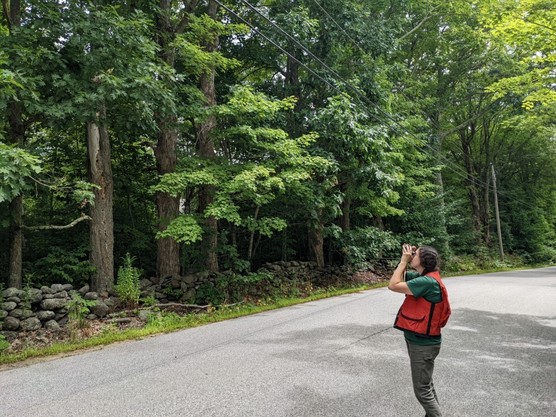 Image: MFS staff survey large sugar maples from the road in North Berwick.
During this survey, trees along the road near the presumed point of collection were observed from the ground. Trunks and branches were closely inspected for any signs of adult beetle activity including egg-laying sites and emergence holes. While surveying older sugar maples, we found many old tap holes, but also some large emergence holes in dead or declining trees. These holes were on several older trees that had well developed columns of rot due to previous pruning. Exit holes were instead likely due to one of our large native cerambycids, such as Centrodera decolorata or Orthosoma brunneum, which prefer dead and dying trees, unlike Anoplophora species which usually attack healthy host trees.
Unfortunately, very little is known about A. macularia and its potential risk to Maine’s trees. To our knowledge, the 2019 specimen was the first time this species had been reported in the United States. Like its cousin the Asian longhorned beetle, this species appears to be able to survive on a wide variety of trees. In Asia, the most significant hosts appear to be citrus, litchi, and mulberry; but it is also documented to attack willow, chestnut, and maple.
DACF will continue to survey the area where the beetle was reported. In addition, we ask for your assistance in looking out for Asian longhorned beetle and similar species, as well as related tree damage. If you suspect you’ve found one of the invasive insects, try to capture it (at least in a picture, but preferably the beetle itself), accurately record where and when you found it, and report it. The department has an extensive resource page on Asian longhorn beetle and other exotic Anoplophora, including reporting instructions.
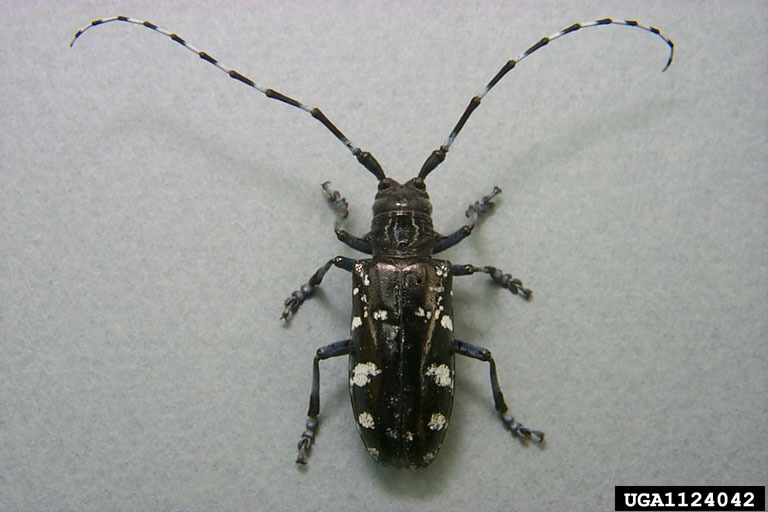 Asian longhorned beetle adults look similar to some of our native woodborers. Check out the resource page (www.maine.gov/alb) for more information. Donald Duerr, USDA Forest Service, Bugwood.org
Beech Leaftier (Psilocorsis spp.)
Now that we’ve got everyone looking for beech leaf disease, we thought we’d point out another interesting thing you might see on beech that is little cause for concern. Beech leaftier larvae can typically be found sandwiched between overlapping sections of different leaves that they’ve tied together with webbing. If you peel these leaf pockets open carefully, you’ll usually uncover a small pale green caterpillar with a dark head, and sometimes several sharing a single pocket. Like many other skeletonizing insects, the amount of damage to individual leaves and to the tree overall is minimal. While we can’t say for certain which species is most common because several species in this genus have similar behavior and use beech for a host, these little larvae belong to the genus Psilocorsis. Some members of this genus also inhabit oaks and chestnuts, as witnessed on a recent site visit to an area with American chestnut trees and pictured below.
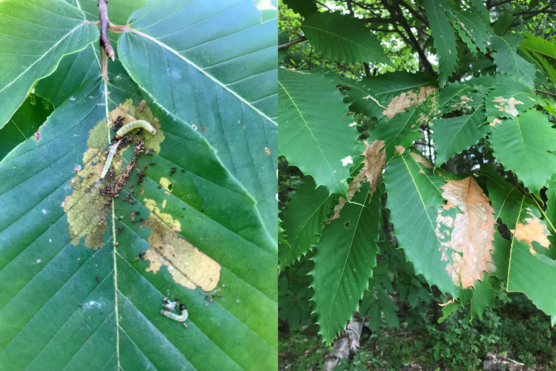 Images: (left) Psilocorsis leaftier larvae exposed by peeling apart protective layers of beech leaves; (right) An example of Psilocorsis larvae feeding on American chestnut.
Browntail moth (Euproctis chrysorrhoea)
Since our last conditions report the adult moths have come and gone; in the capital area, noticeably fewer moths were seen at many lights in town compared to last year. The young caterpillars have been feeding communally for weeks now and their webs have grown in size. These webs will become more compact as the end of their feeding period approaches, typically in late September or early October, depending on weather. The caterpillars and webs of our native fall webworm (FWW) are also present across much of Maine at this time of year and are often confused for browntail moth (BTM) webs. See the comparison article below on how to differentiate these two species of web-building caterpillars.
As the young caterpillars feed, they graze on the outer surface of the leaf without consuming the entire leaf. This damage is called skeletonization and causes the leaf to die and turn a bronzy-copperish color. When we perform our aerial BTM surveys in the late summer, we use this damage to help identify areas where BTM populations are greatest.
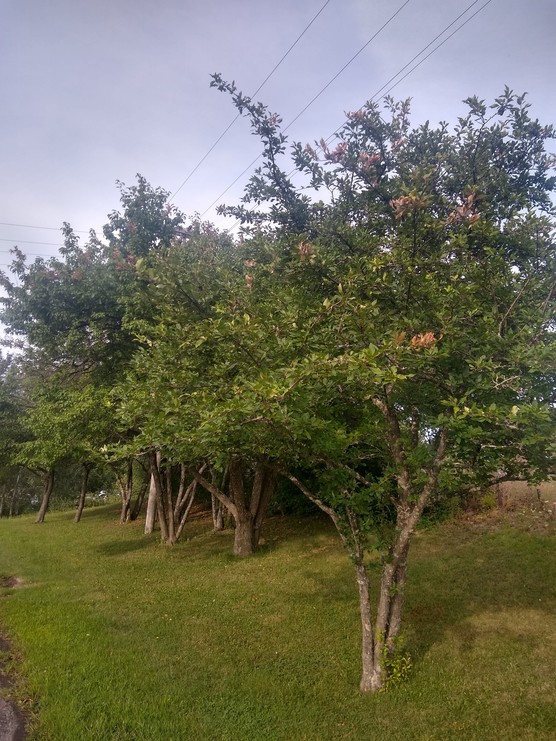 Feeding by browntail moth caused the bronze coloring on the branch tips of this tree in Bangor, ME
Although much less common this time of year, exposure to hairs from previous seasons’ caterpillars can still cause irritation and other symptoms. These exposures are most likely to occur during activities that stir up hairs in the environment, especially during dry conditions. Caterpillar hair exposure can also happen through contact with old pupal cocoons (often in host foliage and sheltered areas), or surfaces on which hairs settled that have not been washed clean. The caterpillars now feeding on the leaves are unlikely to cause a reaction in most people.
Fall Webworm (Hyphantria cunea) vs Browntail moth (Euproctis chrysorrhoea)
As the days get shorter, one of our native caterpillars, fall webworm (FWW), has been busy constructing large prominent webs. Fall webworm is a late-season defoliator whose conspicuous webs are often confused for browntail moth (BTM) winter webs. In late summer, distinguishing between FWW and BTM can be difficult, especially if webs are out of reach.
 Images: (left) Fall webworm (FWW) web encompassing an apple tree branch; (right) Mid-summer browntail moth web. Note the bright white silk surrounding the base of each leaf and its relatively smaller size compared to FWW.
Webs of FWW will often, but not always, be larger this time of year. Here in late-August, fall webworm development has progressed to the point where large, mature caterpillars have constructed loose sprawling masses of webbing and many are wandering freely from their webs. Typically, these webs do not cause lasting harm to the tree as the late season damage is well tolerated by host trees.
Later in the season, as BTM colonies build up silk along their travel routes on the twigs of hosts, their webs grow large. The type of silk can also be used to distinguish BTM (bright white silk on twigs) from FWW (lacking bright white silk). If webs are out of reach, waiting for more distinguishable differences between the two structures in fall may be the only way to determine the resident’s identity.
Often, the easiest way to differentiate between the two defoliators this time of year is the size of the caterpillars. Right now, FWW caterpillars are almost uniformly more than 1” long. In contrast, immature browntail moth caterpillars are much smaller and have only been feeding for about 3 weeks now. BTM caterpillars will generally not exceed ¼” in length until next spring. BTM skeletonizing damage can be extensive in late-summer and early fall, but by mid-fall the nests will be quite compact. Feeding is most often restricted to the outer- and upper-most branch tips of host trees and the nests will remain firmly in place throughout the winter months, unlike the webs of FWW, which will be degraded by fall leaf drop and weathering.
Emerald Ash Borer (Agrilus planipennis)
Last month we reported the finding of emerald ash borer (EAB) in new locations in southern Maine, leading to new areas being regulated by emergency order. We have continued to find EAB in new areas throughout the summer, from a forester and from cooperators checking green funnel traps. These three new finds are within the regulated area. One was in a new town (Yarmouth) and two were in towns where EAB had previously been found (Bridgton and Gorham). At least some of the positive sites discovered using the green funnel traps will be submitted as potential sites for biological control releases.
Recovery sampling in northern Aroostook County began last year in cooperation with local USDA APHIS PPQ and USDA Forest Service Staff. A single female Tetrastichus planipennisi specimen was found by USDA technician Chase Gagne in a yellow pan trap sample collected from one of our Madawaska release sites in the autumn of 2021. Parasitoids were released at that site in 2019 and 2020. The specimen’s identification was recently confirmed by USDA Entomologist Juli Gould.
An update on emerald ash borer and other forest pests, geared towards municipal tree resource managers will take place on August 29 on the MS Teams platform. Information is available on the Calendar.
 Image: Adult Tetrastichus planipennisi, a biological control agent of emerald ash borer. Maine Forest Service
Green Lacewing Larvae (Chrysopidae)
There are many remarkable forms of insect camouflage out there, and we recently received a question about a small unassuming mass of organic matter with legs. Although many green lacewing larvae live life out in the open, the larvae of certain species carry bits of lichen, moss, or other natural debris on their backs to conceal them. This has earned them the affectionate nickname of “junk bugs” or “trash bugs.” Both green lacewing larvae and adults are beneficial predators of primarily aphids, which also earns lacewing larvae the nickname “aphid lions.” Another interesting trait of the green lacewings includes laying eggs on long stalks, to prevent egg cannibalism among larvae as they hatch or predation from other insects. Keep an eye out for the delicate green flying adults in your garden and around lights at night ̶ chances are you may have seen them without knowing what they were.
 Images: (left) The unique stalked eggs of a green lacewing. (right) Example of a green lacewing larvae covered with natural debris to provide protection and camouflage. Images: Whitney Cranshaw, Colorado State University, Bugwood.org; Maine Forest Service.
Hemlock Woolly Adelgid (Adelges tsugae)
As late summer rolls around, remember that the mobile stages of hemlock woolly adelgid (HWA) are no longer present. The tiny crawlers have attached to hemlock twigs at the base of the needles, where they will spend the rest of their lives attached to the tree. They will aestivate (summer ‘hibernation’) for the rest of the summer and early fall and begin feeding and growing in late September or early October. From now until late February, it is safer to work in infested hemlocks because the danger of spreading it to other trees is reduced. It is also safer to work in non-infested areas from the perspective of HWA introduction risk since your clothing and equipment is less likely to carry crawlers or eggs to new places.
We continue to hear of adelgid spreading further into new areas, and of populations expanding in areas where they have become established in recent years. Whitefield (Lincoln County) and North Haven (Knox County) are the most recent towns where HWA has been newly detected. Thank you for reporting HWA in areas where it has not yet been found.
 Image: Tiny crawlers have settled at the base of needles and are now known as nymphs.
Oak Twig Pruners (Anelaphus spp.)
As in other even years in Maine, 2022 was a busy summer for oak twig pruner reports. As larvae tunnel their ways down twigs and branches, branch tips develop discolored leaves and begin to flag. Once larvae complete their two-year development, they chew a final ring around the internal portion of a branch and leave only the outer bark intact, which eventually breaks and then falls to the ground. When this starts to happen, the calls start coming. Despite the widespread and visible damage around Maine, these insects still cause relatively little harm to their host trees. Check out our recently updated Oak Twig Pruners fact sheet for more information on this interesting recurring insect.
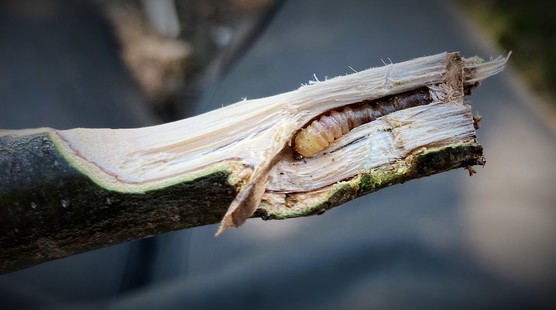 Image: The split open end of a twig severed from an oak tree by an oak twig pruner larva reveals the larva within.
Southern pine beetle (Dendroctonus frontalis)
In response to the 13 beetles captured in a trap located in the Waterboro pine barrens last fall by UNH graduate student Caroline Kanaskie, we have decided to focus on the fall dispersal flights of southern pine beetle (SPB) and adjust our trapping program to operate from August until November. This will give us a better idea of where the beetle is present and in what numbers. A total of 20 traps will be run this year by MFS staff as well as The Nature Conservancy and Acadia National Park. This year traps will be placed at 15 sites (some sites have multiple traps), four of which are new.
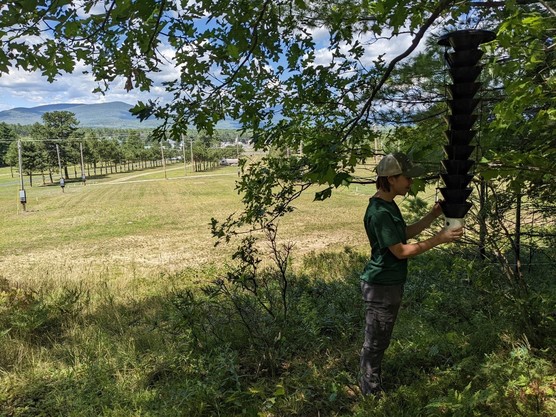 Image: Maine Forest Service intern hanging traps in Fryeburg, ME.
Spongy Moth (Lymantria dispar)
It’s been another big year for spongy moth damage in western Maine. The final aerial survey tally for defoliation in 2022 reached just over 52 thousand acres, compared to roughly 55 thousand acres in 2021. Because we knew spongy moth would be severe again in 2022, we made sure to get up in the air as soon as possible to let people know what was coming. Although these flights capture the bulk of the defoliated area, it is an underestimation of the total area impacted due to continued caterpillar feeding into early July. Towards the end of peak caterpillar activity, precipitation was sufficient to help support diseases that kill caterpillars. With extreme caterpillar populations, these natural controls can spread quite quickly and thoroughly, and there was ample evidence of caterpillar-killing pathogens in the woods.
In mid- and late summer, things have become much more concerning for hardwood recovery and many of the core affected areas remain at abnormal dryness or moderate drought levels according to the statewide drought monitor. As alluded to in the two-lined chestnut borer article below, these are the conditions that can lead to drastic losses of oaks if proper care is not exercised when planning the timing of harvests. Root systems struggling to make up for lost time during defoliation and store resources, as well as secure adequate soil moisture during drought conditions, are especially vulnerable to additional damage from logging equipment. This is a common pathway in which stressed trees are made even more inviting to secondary forest pests that are only able to capitalize on trees in poor condition. Where possible, harvests involving a large oak residual should be postponed for as long as possible, in hopes that we will soon enter the period of population decline and crash following a typical spongy moth outbreak. Those that must go forward should rely on winter harvests with properly frozen ground conditions and consider the amount of oak left behind, being fully aware that these trees might be lost within a few seasons due to the additional stress impacts of forest management activities.
Spruce Budworm (Choristoneura fumiferana)
An early August field trip to spruce budworm country revealed that while spruce budworm (SBW) maintains a presence, it’s a quieter presence in 2022 than in 2021. Those looking carefully can find some evidence of last season’s defoliation and pupal cases still attached to clumps of needles, but only when viewing up close. Our aerial survey flights have not revealed any visible damage in 2022, despite observing about 850 acres of discoloration in 2021. This is true even when flying over the same areas previously mapped in 2021.
The next phase of the 2022 SBW monitoring program will be here soon when pheromone traps that have been hanging in the woods since June and branch samples for overwintering larva monitoring (L2) are collected in early fall. MFS will count trap recoveries as samples come in and the CFRU-funded L2 lab at the University will process L2 samples in a prioritized manner to allow time for further delimiting of populations if necessary. These surveys will give us some insight into the 2023 budworm season.
Two-lined Chestnut Borer (Agrilus bilineatus)
Two-lined chestnut borer (TLCB) is a native woodborer that has rarely if ever made headlines in Maine forest health history but can be a substantial pest of oaks and is commonly encountered in other regions like the upper Midwest. After a harvest in 2019, we received a report from Woolwich (Sagadahoc County) of the oak residual experiencing significant mortality post harvest and were asked to have a look. Upon inspection of several of these dead oaks, it soon became apparent that TLCB activity was a large part of this decline story.
A native insect, TLCB is in the same genus as the invasive and more well-known emerald ash borer and its larvae also leave behind well-defined feeding galleries beneath the bark. Accompanying this old damage, we also found ample fungal evidence of Armillaria root rot. Both TLCB and Armillaria are opportunistic and take advantage of weakened trees. They likely predispose trees to invasion by each other and are all too commonly found working in concert in bringing about the demise of oaks.
Tracing the story back to 2019, we are fortunate to have records of active spongy moth populations right in this area, which helps to further explain the decline of these trees. It is likely that the harvest was performed at a time when trees were being impacted by defoliation or still recovering from defoliation stress. Additional drought stress in 2021 likely played a role in the final stages of decline of these trees, which have manifested now in 2022. Stories like these help to illustrate the importance of harvest timing and why we recommend waiting until stands have had a chance to rebound from major stress events like defoliation before any harvesting activities take place.
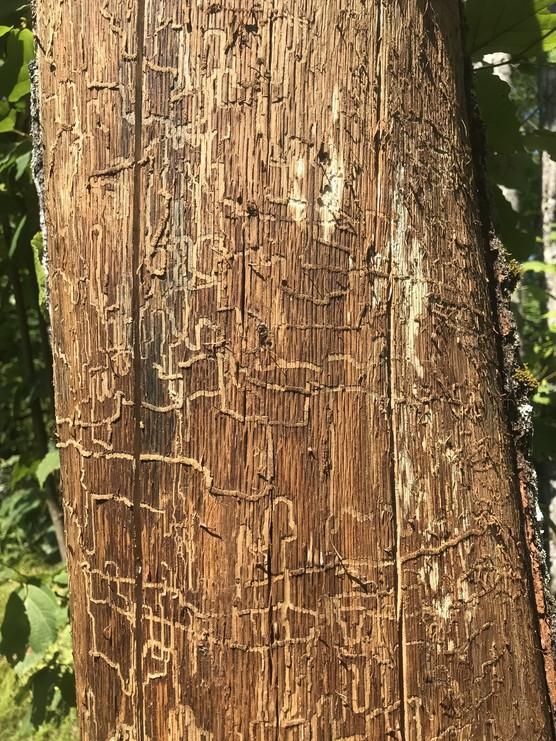 Image: Distinct larval galleries of two-lined chestnut borer left behind on oaks that have succumbed to a combination of post-harvest stress, Armillaria root rot, and insect damage.
Beech Leaf Disease, New detections and Long-Term Monitoring Plots (Litylenchus crenatae mccannii)
The range of detected beech leaf disease (BLD) continues to expand as State staff and the public* continue to send reports and pictures of observations. The most recent confirmed infested area is Deer Isle, where several stands of beech were observed to be in advanced stages of decline from the disease, indicating the disease has been present there for at least two years and perhaps longer. Roadside survey also revealed BLD impacting trees in Castine. To date, BLD has been detected in Hancock, Knox, Lincoln, Penobscot, Waldo and York counties. The York County report from near Mt Agamenticus is the most recent and furthest southern and western report, with the furthest north report from south of Burlington (Penobscot County, unchanged). The easternmost report has shifted with a confirmation of BLD in the Jordan Pond area of Acadia National Park. BLD is expected to occur at varying levels of severity within these geographic boundaries and may occur beyond these boundaries in areas not yet detected. For up-to-date information about BLD in Maine, visit the Maine BLD website.
*MFS IDM has received BLD reports from multiple agencies including the Maine Forest Service, Maine Bureau of Agriculture, Inland Fisheries and Wildlife, Department of Environmental Protection, various land trusts and many reports from the public. This is greatly appreciated and crucial to our understanding of the range of this new and destructive disease of beech trees in Maine.
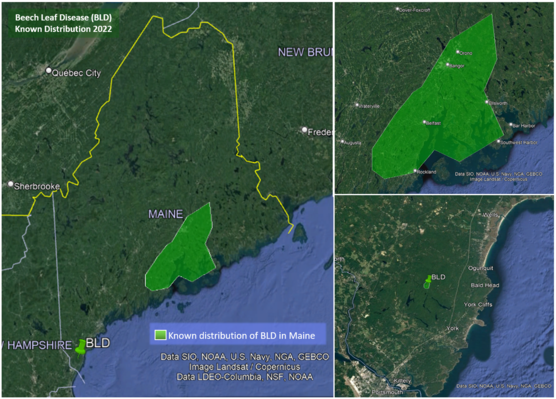 Images: Known BLD distribution in Maine as of August 25, 2022.
 Image: North American BLD distribution as of July 25, 2022.
In other BLD news, another year of funding to support BLD survey and monitoring was secured through efforts from our USFS partners in Durham, NH. Work began in late July on Maine’s BLD long-term monitoring plots. There are currently nine long-term monitoring plots throughout the state. Eight of the plots are in their second year of measurement and one new plot was established this year in York County – BLD was detected there during plot baseline measurements. The intent is to continue measurement of plots on a yearly basis for at least 5 years to demonstrate the progression and impacts of BLD on beech trees in Maine. This long-term monitoring project is part of a regional effort supported by the US Forest Service.
Branch Flagging of Maples
MFS staff have observed and received several reports of randomly dispersed dead maple branches (mostly red and sugar maples), referred to as flags/flagging branches. The leaves on these branches appear wilted and are an eye-catching orange color, alerting homeowners and foresters to a potential tree health issue. Upon surveying several of these branches on maples along roadsides and in front yards, there appears to be several possibilities for this odd branch dieback. In some cases branches have been injured, perhaps by wind during a storm event. In other cases the reason for the symptoms can be insect damage via feeding and boring activities or squirrel damage. However, Some of these branches were observed to have cankers at the base of where symptoms begin. There are several branch canker fungi that are capable of causing these symptoms, such as fungi in the genera Valsa and Phomopsis. These fungi are not particularly virulent (strong/aggressive) pathogens, but are able to attack trees that are under stress. The source of stress is not always clear, but due to past- and current-year drought conditions, the source of stress could certainly be inadequate water and associated above- and below-ground impacts. If practical, these flagging branches should be pruned out of trees as far back as possible, or at least 12 inches behind the last noticeable symptoms. This will also remove sources of new infections, as spore producing structures will eventually form in the vicinity of cankers if they are not already present. If making multiple cuts, it is advised to sterilize the pruning equipment in between cuts with rubbing alcohol or a one-to-five bleach water solution to make sure fungi are not spread via well-intentioned management practices.
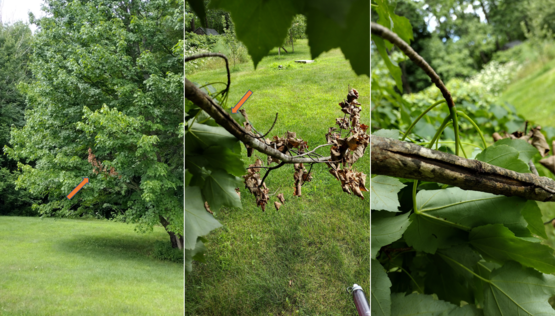 Image: (left) A red maple with a single flagging branch; (middle) A closer look at the branch showing an unidentified elongate branch canker; (right) A close-up of the canker.
Drought
Maine is currently experiencing abnormally dry to severe drought conditions in the lower 3/4 of the state. If these conditions persist further into the growing season, compounding impacts of drought on tree health can be expected. Impacts of drought and secondary drought-related stress can be expected in areas with drought-prone soils and in exposed areas such as along field edges, roadsides and on south-facing slopes. Drought stress can predispose trees to insect and disease attacks, as stressed trees direct more resources to repair and maintenance, leaving less resources for defense. It should be remembered that drought stress has long-term impacts and some of Maine’s trees may still be responding to the drought conditions of May and June 2021. Likewise, even though the rainfall total for 2021 appears to be a bit below average, acute periods of drought in 2021 caused damage to trees leading to long-term impacts in some cases. MFS staff have indeed seen tree health impacts this growing season that could be at least partially linked back to drought stress from 2021, such as stress-related fungal cankers and insect infestations, primarily by bark beetles and boring insects.
 Image: U.S. Drought Monitor from July 19, August 4 and August 16, 2022.
Dutch Elm Disease (Ophiostoma ulmi, Ophiostoma novo-ulmi)
Reports of Dutch elm disease (DED) symptoms have increased in July and August. Anectdotal reports and observations from around the state indicate that DED is more prevalent this year than in previous years. The reason for this is not known. Symptom progession has been noted to be more rapid than usual in trees with DED. Published research suggests that elms infected with the fungus that causes DED that are also exposed to water deficit show more severe symptoms and faster progression of symptoms than those that are not exposed to water deficit. The current extended period of abnormally dry to severe drought conditions throughout most of Maine (see Drought section in this report) could support received observations and reports. The stages of decline due to DED can be seen in the image associated with this article. The status of this mature elm has been followed over the past year by MFS Forester, Dan Jacobs who has taken and submitted images of the tree in Littleton Maine.
 Image: (left) An American elm tree in the early stages of infection in Littleton, August 16, 2021; (middle) The same tree is pictured in June 2022 and (right) July 2022. Images Courtesy of Dan Jacobs MFS.
Flagging Conifer Branches
Similar to the motivation for the article ‘Branch Flagging of Maples’, MFS staff have observed and received several reports of randomly dispersed dead balsam fir and spruce branches on trees throughout Maine, many on forest and field edges and near roads. The needles on these affected branches are an eye-catching orange color. Similar to the situation with maples, stress-related canker fungi in the genera Phomopsis, Valsa (Cytospora canker of spruce, but also other conifers) and Diplodia (more frequently associated with pine tip dieback) have been recorded in other states parasitizing trees’ vascular tissues at the base of symptoms. One can suspect the same fungi occur in Maine. Of course other agents can be responsible for the damage, like insects, animals or storm damage. In any instance, these dead and dying branches can be pruned all the way back to the main stem, or at least 12 inches behind cankers. This will improve the appearance of the tree and remove cankers that may eventually expand and form spore-producing structures near the margins of the canker leading to more future infections in the same tree and neighboring trees. Pruning equipment should be sterilized between cuts with rubbing alcohol or a one-to-five bleach water solution to make sure fungi are not spread via well-intentioned management practices. If practical, cultural management practices to address the source of stress are recommended.
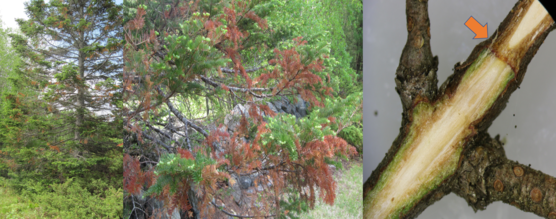 Images: (left) A fir tree with several flagging branches; (middle) A close-up of flagging branches; (right) A close-up of a small branch with dieback, with the bark removed, showing the junction where dead tissue killed by the canker fungus meets still living tissue.
 Images: (left) White fungal mycelia of the fungus causing Armillaria root disease on a recently killed balsam fir tree; (right) The flat fungal strands (rhizomorphs) of the Armillaria fungus on dead wood responsible for the common name of the fungus, ‘shoestring rot’.
When whole-tree symptoms are seen developing quickly in spruce and fir, often Armillaria root disease is to blame. Armillaria root disease, also called shoestring rot due to the flat and black fungal structures made by the fungus, parasitizes the vascular tissues at the root collar, restricting water to the top of the tree. Armillaria fungi are common throughout the environment but seldom successfully attack healthy and vigorous trees. Armillaria species are highly capable of exploiting the weaknesses of stressed trees, leading to potentially rapid decline and mortality. This is especially seen when Armillaria root disease impacts stressed balsam fir.
From our August 21, 1992 Conditions Report:
“Locust leafminer (Odontota dorsalis): Black locust along Stetson Brook in Lewiston are again brown from mining of the larvae of this beetle. This area was heavily infested in 1990 but much less so in 1991. Beetles were very active this week. This appears to be the only infestation of O. dorsalis found so far in Maine. The more common and widespread digitate miner, Parectopa robiniella, appears to be down in numbers this year.”
August 29, 2022, 10 am: via Teams Emerald Ash Borer (EAB) and other Tree Health Concerns: Update for Maine Cities and Towns
The Maine Department of Agriculture, Conservation and Forestry is hosting a quarterly conference call to update city and town tree and forest managers, public works staff and any interested land managers on the known status of emerald ash borer in Maine, current state efforts, municipal opportunities, and plenty of time for Q&A. The call will begin at 10:30 AM on Monday, August 29th and will run no more than 1.5 hour. Please share with municipal tree managers and others within your community government who may be interested (tree warden, arborist, public works, parks, transfer station, land stewards etc.) This month’s call will take place on the Microsoft Teams Webinar platform.
September 9, 2022, 9am: via Teams Overview of Winter Moth Biological Control - Forestry Friday Webinar
University of Massachusetts’ Elkinton Lab will provide an overview of current efforts to understand and promote biological control of winter moth (Operophtera brumata). Winter moth is an invasive moth species causing coastal hardwood tree and forest damage and mortality in Maine. For more than a decade it caused more extensive impacts in eastern Massachusetts, eventually spreading to Rhode Island and Connecticut. In those states, winter moth is now largely under control thanks to natural enemies and the work of the Elkinton Lab and their cooperators.
Register Online Here
Conditions Report No. 4, 2022
Online
Department of Agriculture Conservation & Forestry, Maine Forest Service – Forest Health and Monitoring
Contributors: Aaron Bergdahl, Amy Emery, Allison Kanoti, Mike Parisio, Thomas Schmeelk, and Colleen Teerling.
Unless otherwise noted, images by Maine Forest Service, Forest Health and Monitoring, DACF.
|